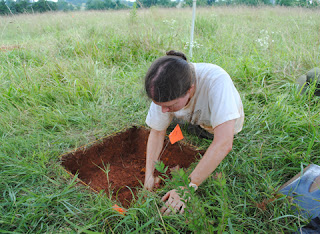The
process of putting a land patent into ArcGIS from start to finish involves
several steps. I downloaded patents from the website “The Library of Virginia’s
Land Office Patents and Grants.” I
searched for keywords, including geographical features like “Deep Creek”, and
names, such as “Francis Eppes.” I also
set up a base map using georeferenced* topographic maps and aerial
imagery. The patents were then placed on
top of the base map. After being placed
on the base map, property boundaries were evaluated to see where other patents
might be located. For example, on Eppes’
patent, Henry Anderson’s line is mentioned, so I searched for his patent
next. I also had to taken magnetic
declination into consideration. Since
magnetic north today is not the same as magnetic north was in 1730, I had to account
for this by angling the patent a specified degree. Finally, to evaluate the accuracy of the
patent, I measured acreage.
Patents were surveyed differently in the 18th
century than they are surveyed today. Land
surveyors used a compass and a Gunter’s Chain, which consisted of linked
chains. Surveyors measured distances
using the measurement of chains, poles, and links. If a patent reads “West seventeen degrees
North seven hundred and thirty four poles”, the bearing is seventeen degrees
north of west 12,111 feet. Once a map was digitized, I made notes in regards to
boundary references, such as “Anderson’s
line”. Through this process, I was able
to digitize patents and their neighbors.
Fitting a patent onto the base map in the best
possible relation to its neighboring patents was one of the most challenging
and frustrating parts of the process. In
most cases, it was easy to see how a patent fit in relation with its neighbors.
Pinning a patent to a specific point on the map, however, was more difficult. I
used several control points, mostly creeks, to try to establish the most
accurate location for the patents on the landscape. Pinning a creek as mentioned in a patent to a
modern day creek on an aerial image or a topographic map was sometimes problematic,
especially if the modern creek had not maintained its historic name. I contacted multiple government (local,
regional, and national) agencies to try and identify smaller creeks not
identified on modern maps, with no success.
My educated guesses placed creek names with modern creeks. The accuracy of the patent placement depends
on the correctness of creek names, making this a significant step in the process. Historic roads referenced in patents or land
transactions were also identified in order to give the area a proper context,
and intersections of roads were used as control points where possible.
In addition to land patents, I also
traced land transactions in order to obtain an overall view of the land. I spent time searching through deed and will
books from Goochland, Cumberland, and Powhatan Counties and put these finding
into ArcMap. It was necessary to search three counties’ deed books due to the
division of the area from one large county into smaller counties over time. Knowing
a patent’s history and its division over time could help fine-tune a patent’s
placement, particularly when specific geographic markers were used. Part of the
overall complexity resulted from the difficulties of keeping track of the
changing land owners. Land was
frequently divided. This impacted
property boundaries, as they were constantly changing.
Inconsistencies and errors within the
deeds themselves, in addition to illegible handwriting and missing parts of
pages, sometimes complicated this process.
Several patents were simply incorrect, while others were impossible to
digitize into ArcMap due to their lack of specificity. Sometimes a distance or a direction was omitted. In many patents and transactions the phrase
“down the Branch according to the Meanders” appeared, which provides no
distance or direction. A related problem
was a lack of specificity in the documents.
To illustrate, Eppes’ will indicates that his daughter Ann was to
receive the lower end of the moiety, while Martha was to receive the upper end
of the moiety. What Eppes meant by lower
and upper was unclear. However, by
keeping track of boundary references over time, this issue can be partially solved. Another inconsistency arose involving
incorrect statements in the transactions.
Issues like these complicate the process. However, more often than not, I could
successfully digitize patents and transactions into ArcGIS.
Crystal
Ptacek
*tied to map
projections or coordinate systems













